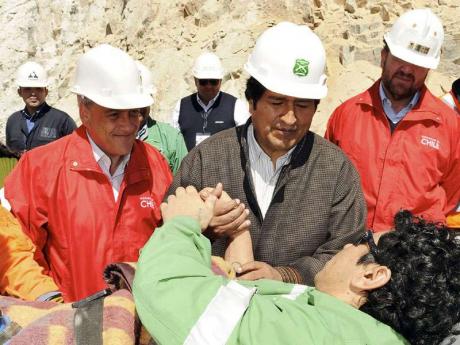Those plucky Chilean miners
Gordon Robinson, Contributor
The much ballyhooed rescue of 33 Chilean miners is undoubtedly the feel-good story of the millennium. But, if we're to learn the correct lessons from this story of the triumph of the human spirit over the consequences of corporate greed we must delve behind the American news networks' self-indulgent coverage and try to understand what really happened during those 68 days of horror for these brave men.
CNN's coverage, in particular, featuring as it does the standard US arrogance, has been grossly jingoistic and viewers are made to believe (with the help of the all-too-willing-to-grovel Chilean ambassador to the US) that the rescue was all about a magic machine exported in record time from Pennslyvania without which the miners wouldn't be alive today.
As usual, the truth is simpler and includes a mixture of luck and a glowing example of outstanding Chilean leadership, discipline and team spirit. Mark you, the US isn't alone in its ulterior motives and, as we will see, Chilean politicians have their own axes to grind, but the heroism of the miners and the Chilean rescue teams is in danger of being lost in the US hype.
I know it seems nonsensical to talk about 'luck' in such a tragedy, but consider this. The rockfall that trapped the miners took place around noon when the men were on their lunch break and eating under a reinforced rescue shelter 700m below the surface. Had it happened at any other time these men would've been scattered across four miles of tunnel and most of them would've died instantly. So, as bad as their ordeal was, and as linked to corporate greed as the "accident" was, it began with a huge stroke of luck.
The second lucky stroke was that the landslide left about a kilometre of stable area around the rescue shelter which included several vehicles whose batteries were used to power torches. One vehicle actually had a supply of bottled water which would become vital in the early days of the entrapment.
There were two more items of good luck that didn't come from Pennslyvania. The next one (hopefully Miss World member of parliament is reading) was that the mine was a copper mine which, unlike unsafe(r) coal mines, doesn't emit the potentially deadly methane gas. So, like the condemned man in the movie FALLEN (starring Denzel Washington), these miners knew from the outset that time was on their side since, despite the blockage of all ventilation shafts, their breathing would be the only drain on the remaining oxygen supply.
Finally, the most crucial piece of luck was the small amount of emergency food supply in the rescue shelter and the leftovers from the lunches they were eating when the landslide happened. They immediately got together and worked as a team to develop a rationing system. Leaders emerged and the men agreed that each person would eat only two teaspoons of canned tuna and a biscuit every 48 hours.
supplemented
Each of these "meals" was to be washed down with two sips of milk and nobody started eating until everybody's "meal" had been shared out. They supplemented the bottled water found in the tractor by digging a makeshift canal and, as an option of last resort, drained the radiators of the vehicles. They stuck together; spoke together; prayed together; and swore that nobody would ever speak of any tensions that may have existed.
"In the event of something happening to me, there is something I would like you all to see.
It's just a photograph of someone that I knew. Have you seen my wife, Mr. Jones? Do you know what it's like on the outside? Don't go talking too loud, you'll cause a landslide, Mr. Jones."
The men created a structure, a plan of action and a routine (including sending out scouting groups looking for signs of rescue) that made their living conditions more bearable and kept morale up. "I keep straining my ears to hear a sound.
"Maybe someone is digging underground, or have they given up and all gone home to bed, thinking those who once existed must be dead."
A second rockfall two days after the first one closed off another 100 yards of tunnel, but they did not despair. Finally, two weeks after the first rockfall, a probe found its way through a wall yards from the rescue shelter. Weeks of digging had resulted in several near misses but, long before the matter became an international celebrity, the Chilean president had committed every national resource to the rescue from day one and there was no easing off. The probe came back with a note from the miners scribbled on a scrap of paper by the oldest of the trapped men: "Estamos bien en el refugio los 33" (all 33 of us are fine). This gave the rescuers the breathing space (no pun intended) they needed to plan the rescue professionally. And what a job they did!
Food, drink, medical supplies, clothing and material for entertainment were sent down regularly through a tube. The first request that came back up the tube was for toothbrushes. They were immediately sent down. The miners were made to speak to psychiatrists daily to keep their spirits up. When some of the more macho among them refused to do so, entertainment rations were withheld until they recanted. All this became possible due to a system of communications called 'la paloma" (the dove) created by a Chilean national and mining rescue expert, Miguel Fortt, by which a three-metre long PVC tube was lowered to the men by cable and whatever could fit in that was delivered back and forth.
La paloma was upgraded over time but remained the critical lifeline for the trapped men for the period of their incarceration. Even TV and music came through that pipeline to the men underground.
The natural leader of the miners was Luis Urza (a.k.a "Don Lucho"), a 54 year-old topographer and the eldest son of a large Roman Catholic family. He organised the men into groups with separate responsibilities and a daily routine that made the time pass faster than otherwise. A natural waterfall about 300 metres from the shelter provided a daily shower. Shampoo came through La Paloma.
withdrawn
The requests for cigarettes and wine were refused but, when the men went on "strike" (refusing to speak to psychologists), the TV/music was withdrawn and, when the men relented, cigarettes were sent as a reward.
So this was a multifaceted, brilliantly planned and coordinated rescue attempt and, while it is true that one of three drills in operation came from Pennslyvania and significantly reduced the rescue time, it had little to do with the happy scenes of fit and fresh men bounding out of their rescue capsules, hugging family and friends and leading cheers. That was a two-month process involving the very best example of how to come together as a nation for a single goal to rescue your fellow men. The Liverpool football club might consider hiring some Chilean consultants. Of course, there are moral downsides as well. The episode is already being made to conform with Goodman's Law ("It's always about the money"). Consider the following:
• The American money machines have already arranged book deals and talk show tours;
• One of the miners amused his friends by singing Elvis songs so Graceland has offered a fully paid up trip for him and his family;
• In a smart product placement move, the dark glasses worn by the miners on exiting the mine were Oakleys (buy one get one free?);
• Chile's president was once the owner of Chile's largest network. Any surprise that the first miner out handed a 'souvenir rock' to the Prez (One small step for man?), flags were on hand to be draped around shoulders and the national anthem was sung by all?
The lyrics quoted in this piece come from the prolific pens of Maurice Gibb (music); Robin Hugh Gibb and Barry Gibb (lyrics) who would be better known to readers as the Bee Gees. The song, entitled "New York Mining Disaster 1941" had nothing whatever to do with any mining disaster in New York (a state unlikely to feature coal or copper mines, although sand, limestone and zinc mines do exist among others) but was inspired by a horrific disaster occurring in 1966 in the Welsh village of Aberfan where a colliery spoil-tip collapsed. The Welsh National Coal Board (NCB) had built a colliery directly above the village and one of the tips (huge piles of loose rock and mining slag built up over layers of highly porous sandstone containing numerous underground springs,) had been located directly above the village primary school despite the local authorities raising specific concerns in 1963 which were largely ignored by the NCB's area management.
Those trapped by the 1966 tip collapse weren't as lucky as the 2010 Chilean miners. One hundred and sixteen children and 28 adults were killed.
Peace and Love.
Gordon Robinson is an attorney-at-law. Feedback may be sent to columns@ gleanerjm.com


